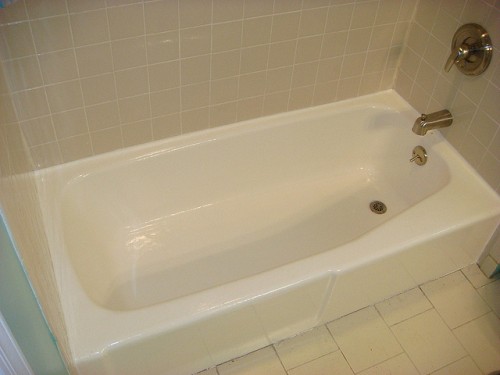How to Use Silicone in my Bathroom?
 What is silicone? Well, imagine a super substance which is:
What is silicone? Well, imagine a super substance which is:
- Water repellent
- Heat resistant
- Non-toxic
- Mold- and fungus-resistant
- Long-lasting
- Strong, yet flexible and rubberlike
That's silicone for you. This useful material can shape-shift into various forms. It's caulk, it's grease, it's resin, it's rubber! In home improvement terms, "silicone" usually describes the caulk incarnation.
Find out why and how to use silicone in the bathroom.
Why is Silicone Important in my Bathroom?
Quick -- name the wettest room in your home. Unless you have a houseful of very inventive toddlers, you probably answered "the bathroom."
And water + soap, shampoo, or toothpaste = good hygiene.
But water + seepage into walls or floor = big trouble.
If moisture penetrates into parts of your home where it's not supposed to be, like your subfloor or your tile backer board, it will eventually cause serious damage. Think structural weakening (yikes!) and the growth of mold and mildew (eew!).
Silicone to the rescue! Apply moisture proof silicone caulk to seal the gaps between surfaces in your bathroom and prevent leakage. Use it any place two surfaces join together. Here are just a few examples of how to use silicone in the bathroom:
- the edge of the sink, where it meets the vanity or your tile backsplash
- the side of your bathtub, where it joins the tile tub surround
- the top of a tile wall, where it connects to the bathroom ceiling
- the edge of a toilet, where it meets the tiled floor
Where Do I Buy Silicone Caulk?
Purchase silicone caulk at your local hardware shop or home store. There are several types available. The traditional form is a sort of goo that comes in a plastic canister to load into a special refillable metal holder called a "silicone gun." It's the most cost-effective for large jobs. You can also buy the caulk in a small squeezable tube or opt for a silicone spray.
How Do I Apply it?
Silicone Caulking 101: The devil is in the details, so before you apply any type of silicone sealant to a bathroom surface, do your prep. Read the directions on the packaging. Then ventilate the room -- silicone releases ammonia as it cures. Put on good quality latex gloves to keep that ooey goo off your hands. Make sure that the area you are about to caulk is clean as a whistle. Remove any existing yellowed, and/or cracked silicone with the aid of a utility knife. Use a clean rag soaked in rubbing alcohol to remove dirt, grease, oil, or soap residue.
When using the spray, simply shake the can, position it 15" from the surface, and spritz on evenly. Working with the caulk type is a bit trickier. If you are a silicone caulking newbie, you might want to practice getting a smooth line on a piece of cardboard first. Hold the applicator at a 45-degree angle and apply in a steady motion. Press down the length of the caulk with your dampened fingertip (this is where the latex gloves come in handy) to ensure you've created a good seal.
How Can I Clean Up?
As we hope you've learned by now, silicone caulk is pretty easy to apply. Now here's the bad news: if you did a messy job, it can be a lot harder to remove excess caulk from your skin (we told you to wear gloves!) or bathroom surfaces. The trick is to move fast, before it has a chance to dry completely. Immediately rub off whatever you can with paper towel. Scrub your hands thoroughly with soap and water; then scrape off any large pieces of caulk. Loosen leftover residue with acetone or rubbing alcohol and wash your hands again.
Remove silicone from tile or other hard surfaces by first spraying with compressed air to make it more brittle. Slice across the caulk in a few places using a razor blade ... gently does it for the sake of the tile and your hands. Finally, pry off the silicone with a putty knife. Once again, move delicately so you won't end up scratching your tile.
Does all this sound like a lot of work? Never fear, you can always hire a reliable tile contractor to do the job for you.
Laura Firszt writes for networx.com.
Updated September 9, 2018.
Looking for a Pro? Call us (866) 441-6648

Tile Contractors Experiences

Outstanding Tile Installation Based On My Own Design

Tile Installation For New Kitchen Backsplash And Guest Bathroom Floor



